100 Years Ago
- Penny Colman
- Jul 17, 2023
- 5 min read
Today, July 17, 100 years ago, seventy-three-year-old, Mary Harris "Mother" Jones's army of striking mill workers, including many child workers, spent the night in Newark, NJ. The next two nights they were in Paterson, then on to Passaic where Jones discovered that President Theodore Roosevelt's Secret Service had been following the army. In fact, two agents stayed in the hotel room next to hers and took turns spying on her through the keyhole of the connecting doors. The march had started ten days earlier in Philadelphia. (First image: "Mother Jones's Army Marches Valiantly On," The Evening World, July 8, 1903, p. 3)
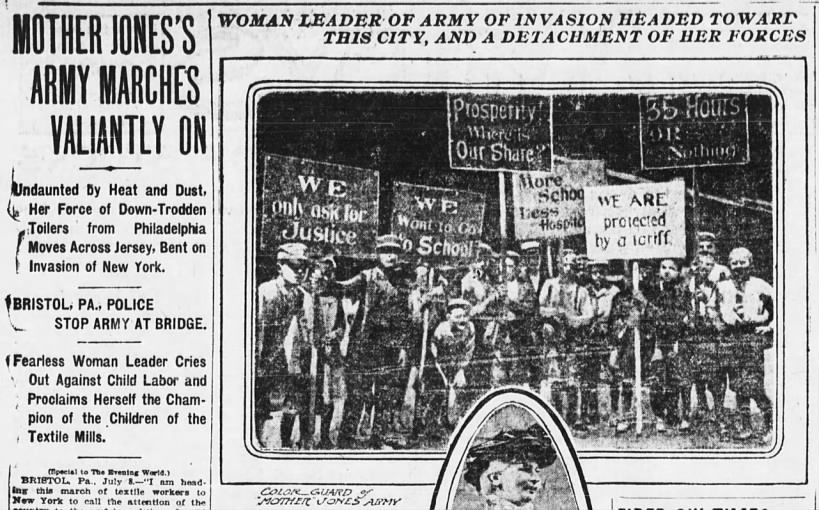
A self-described "hell-raiser" for the rights of miners, railroad workers, and mill and factory workers, Mother Jones had gone to Philadelphia, Pennsylvania, in June. More than 100,000 workers including 16,000 children in six hundred textile mills were on strike because mill owners refused to shorten the workweek from sixty hours to fifty-five. Particularly concerned about the effects of the long hours on the health of children workers, union member even offered to take a cut in pay for shorter hours.
Mother Jones spent long hours organizing, participating in mass meetings, parade, picnics, and peaceful demonstrations. She talked to the children: "Every day little children came into Union Headquarters, some with their hands cut off, some with the thumb missing, some with their fingers off at the knuckle. They were stooped little things, round shouldered and skinny."
When newspaper reporters told her that they weren't writing "the facts about child labor" because the mill owners had stock in the newspapers and controlled what the papers published, she replied: "Well, I've got stock in these children, and I'll arrange a little publicity."
First, she held a demonstration at City Hall. "I put the little boys with their fingers cut off and hands crushed and maimed . . .and showed them to the crowd." A fiery orator, she talked about children being "sacrificed on the altar of profit" and "millionaire manufacturers" who commit "moral murder." Newspapers covered the event. "That was what I wanted—public attention on the subject of child labor," she later explained. But the attention didn't last long, so Jones "concluded that people needed stirring up again."
On July 5, 1903, Mother Jones spoke at a huge meeting for strikers. She told them about her plan to march with mill children some 125 miles to visit the President of the United States, Theodore Roosevelt, who was in residence at his summer home in Oyster Bay on Long Island. She assured the parents that she would bring their children back "safe and sound." The strikers voted to support her.
On July 7, Mother Jones flanked by an eight-year-old boy, Danny Thomas, and an adult, Charles Sweeney, the chief marshal twirling a red, white, and blue baton, lead almost three hundred marchers, including nearly two hundred young children. They were accompanied by a fife-and-drum corps, three wagons loaded with supplies, and one wagon for children who needed a ride. Each child carried a knife, fork, tin cup, and plate in a knapsack.
Day after day national and international newspapers carried accounts of Mother Jones and her march of the mill children. "MOTHER JONES" LEADS A PILGRIMAGE declared the Daily Mail a newspaper in England. ( Daily

Mail, Hull, Humberside, England, July 8, 1903, p. 2.) An Indianapolis newspaper reported that "footsore and weary" marchers were dropping out. "Heat Thins Army of Mother Jones," read the headline of a New York City newspaper.
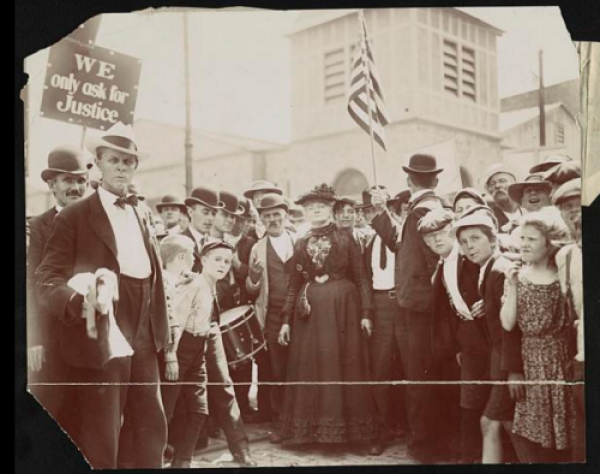
Nevertheless Mother Jones marched on, holding demonstrations, making dramatic speeches, giving lively interviews. and making attention-getting announcements such as: "We are going to New York to call on J.P. Morgan. He has promised us some of the $40,000,000 or $50,000, 000 he owns, and we will march to his office to collect it." When the police commissioner of New York City refused to give her a parade permit, she went to the mayor and pointed out that the city had recently had two parades for visiting princes, once from England the other from China. "Why can't a few American citizens walk quietly through your streets and display their banners calling for better conditions for the babies of the mills?" she asked. "MOTHER" JONES'S ARMY PARADES IN NEW YORK, read the headline in The Los Angeles Times. (July 24, 1903, p. 2)

.On July 27, Mother Jones boarded a train for Oyster Bay. She took three young mill workers and two union men and their wives. They got off the train and walked the short distance to Roosevelt's beautiful home. Roosevelt's Secretary, Benjamin F. Barnes, met them. The president "has nothing to do with such matters and could not assis her 'children' in the struggle for better conditions," he told Mother Jones. Write the president another letter, Barnes advised her.
"I feel that no nation can be truly great, while such conditions exist without attempting a remedy," Mother Jones wrote in her letter to Roosevelt. (Right image: Article in a Minneapolis, Minnesota newspaper, Star Tribune, July 30, 1903, p. 1. Left image: This cartoon is in my book Mother Jones and the March of the Mill Children.)
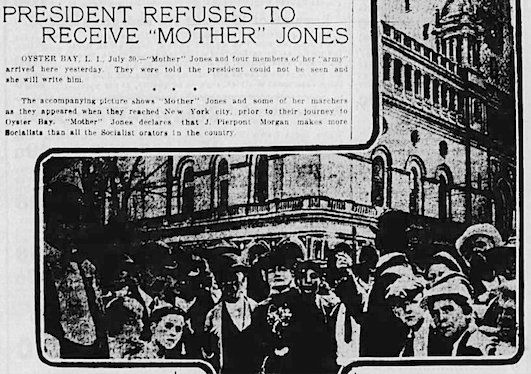
On August 4, Jones and her remaining marchers returned by train to Philadelphia. "Our march had done its work. We had drawn the attention of the nation to the crime of child labor."

Mother Jones was right that her march had drawn attention. In 1905, two years after her march, the Pennsylvania legislature passed child labor laws. State after state passed similar laws. Eventually in 1938, under the guidance of Secretary of Labor Frances Perkins, a federal child labor law was passed. Here is an excerpt from my book, A Woman Unafraid: The Achievements of Frances Perkins: "The need for child labor laws to prohibit employers from hiring young children was a subject Perkins spoke about frequently. She ended her speeches by reciting "Little Toiler," a poem by Sara N. Claghorn, which ended with this verse:The golf links lie so near the mills,/That nearly every day,/The laboring children can look out/And see the men at play.
I am writing this post to honor the centennial of Mother Jones and the March of the Mill Children. I also want to highlight the fact that today in state after state Republican dominated legislatures have passed or have introduced laws backtracking protective child labor laws such as laws governing the number of hours children can be employed and restrictions on dangerous work. According to a recent article in The Nation, “Iowa now allows those as young as 14 to work in industrial laundries. At age 16, they can take jobs in roofing, construction, excavation, and demolition and can operate power-driven machinery. Fourteen-year-olds can now even work night shifts and once they hit 15 can join assembly lines.”
Fraser, S. (2023, July 13). Child Labor in America is Back—and It’s As Chilling as Ever. The Nation. https://www.thenation.com/article/economy/child-labor-industrial-capitalism/
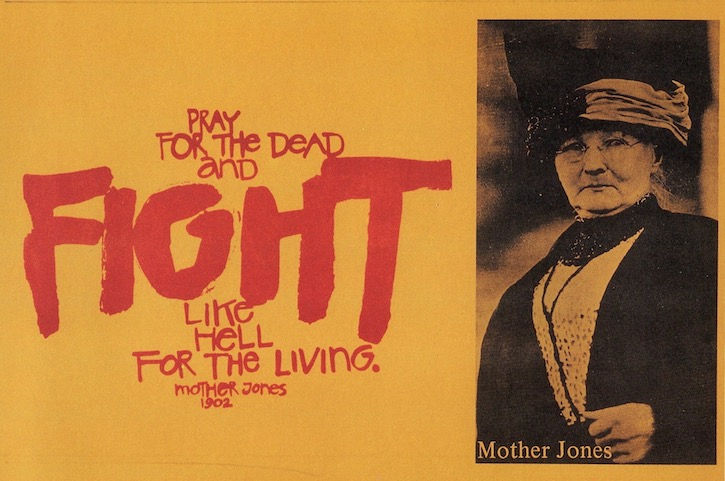

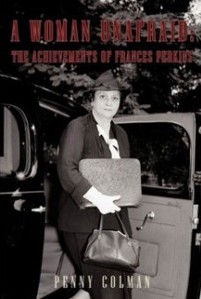
Comments